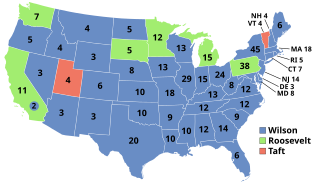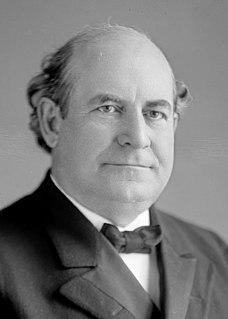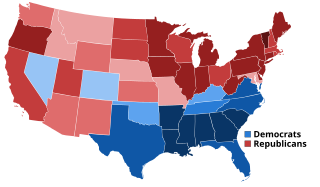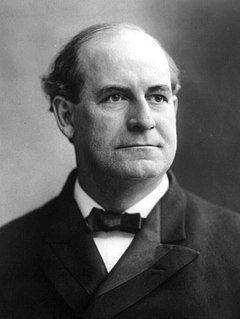
The 1896 United States presidential election was the 28th quadrennial presidential election, held on Tuesday, November 3, 1896. Former Governor William McKinley, the Republican candidate, defeated former Representative William Jennings Bryan, the Democratic candidate. The 1896 campaign, which took place during an economic depression known as the Panic of 1893, was a political realignment that ended the old Third Party System and began the Fourth Party System.

The 1900 United States presidential election was the 29th quadrennial presidential election, held on Tuesday, November 6, 1900. In a re-match of the 1896 race, incumbent Republican President William McKinley defeated his Democratic challenger, William Jennings Bryan. McKinley's victory made him the first president to win a consecutive re-election since Ulysses S. Grant had accomplished the same feat in 1872.

The 1904 United States presidential election was the 30th quadrennial presidential election, held on Tuesday, November 8, 1904. Incumbent Republican President Theodore Roosevelt defeated the Democratic nominee, Alton B. Parker. Roosevelt's victory made him the first president who ascended to the presidency upon the death of his predecessor to win a full term in his own right.

The 1908 United States presidential election was the 31st quadrennial presidential election, held on Tuesday, November 3, 1908. Secretary of War and Republican Party nominee William Howard Taft defeated three-time Democratic nominee William Jennings Bryan.

The 1912 United States presidential election was the 32nd quadrennial presidential election, held on Tuesday, November 5, 1912. Democratic Governor Woodrow Wilson unseated incumbent Republican President William Howard Taft and defeated former President Theodore Roosevelt, who ran under the banner of the new Progressive or "Bull Moose" Party. As of 2021, this is the most recent presidential election in which the second-place candidate was neither a Democrat nor a Republican.

William Jennings Bryan was an American orator and politician. Beginning in 1896, he emerged as a dominant force in the Democratic Party, running three times as the party's nominee for President of the United States in the 1896, 1900, and the 1908 elections. He also served in the House of Representatives and as the Secretary of State under Woodrow Wilson. Because of his faith in the wisdom of the common people, he was often called "The Great Commoner".
The People's Party, also known as the Populist Party or simply the Populists, was a left-wing agrarian populist late-19th-century political party in the United States. The Populist Party emerged in the early 1890s as an important force in the Southern and Western United States, but collapsed after it nominated Democrat William Jennings Bryan in the 1896 United States presidential election. A rump faction of the party continued to operate into the first decade of the 20th century, but never matched the popularity of the party in the early 1890s.

Robert Marion "Fighting Bob" La Follette Sr., was an American lawyer and politician. He represented Wisconsin in both chambers of Congress and served as the 20th Governor of Wisconsin. A Republican for most of his life, he ran for president of the United States as the nominee of his own Progressive Party in the 1924 presidential election. Historian John D. Buenker describes La Follette as "the most celebrated figure in Wisconsin history".

John Worth Kern was a Democratic United States Senator from Indiana. While the title was not official, he is considered to be the first Senate majority leader, while serving concurrently as chairman of the Senate Democratic Caucus. He was also the Democratic vice presidential nominee in the 1908 presidential election.

The Progressive Party was a third party in the United States formed in 1912 by former president Theodore Roosevelt after he lost the presidential nomination of the Republican Party to his former protégé and conservative rival, incumbent president William Howard Taft. The new party was known for taking advanced positions on progressive and populist reforms and attracting leading national reformers. After the party's defeat in the 1912 presidential election, it went into rapid decline in elections until 1918, disappearing by 1920. The Progressive Party was popularly nicknamed the "Bull Moose Party" when Roosevelt boasted that he felt "strong as a bull moose" after losing the Republican nomination in June 1912 at the Chicago convention.

The Fourth Party System is the term used in political science and history for the period in American political history from about 1896 to 1932 that was dominated by the Republican Party, except the 1912 split in which Democrats held the White House for eight years. American history texts usually call the period the Progressive Era. The concept was introduced under the name "System of 1896" by E. E. Schattschneider in 1960, and the numbering scheme was added by political scientists in the mid-1960s.

The 1904 Democratic National Convention was an American presidential nominating convention that ran from July 6 through 10 in the Coliseum of the St. Louis Exposition and Music Hall in St. Louis, Missouri. Breaking with eight years of control by the Democratic Party's reform wing, the convention nominated conservative Judge Alton B. Parker of New York for president and Henry G. Davis of West Virginia for vice president.

The 1908 United States presidential election in Nevada was held on November 3, 1908 as part of the 1908 United States presidential election. Voters chose three representatives, or electors to the Electoral College, who voted for president and vice president.

The 1900 United States presidential election took place after an economic recovery from the Panic of 1893 as well as after the Spanish–American War, with the economy, foreign policy, and imperialism being the main issues of the campaign. Ultimately, the incumbent U.S. President William McKinley ended up defeating the anti-imperialist William Jennings Bryan and thus won a second four-year term in office.

After U.S. President William McKinley was assassinated in 1901, Theodore Roosevelt became the new U.S. President. Roosevelt's first term was notable for his trust busting, his successful arbitration in and resolution of a 1902 strike of 150,000 Pennsylvania coal miners, his advocacy against lynching, his conservation efforts, and the Panama Canal Treaty. In 1904, Roosevelt easily defeated Bourbon Democrat Alton Parker and won a second term as U.S. President.

The 1908 United States presidential election in Ohio was held on November 3, 1908 as part of the 1908 United States presidential election. State voters chose 23 electors to the Electoral College, who voted for president and vice president.

The 1908 United States presidential election in Maryland took place on November 3, 1908. All contemporary 46 states were part of the 1908 United States presidential election. State voters chose eight electors to the Electoral College, which selected the president and vice president.

The 1908 United States presidential election in Washington took place on November 3, 1908. All contemporary 46 states were part of the 1908 United States presidential election. Voters chose five electors to the Electoral College, which selected the president and vice president.

The 1908 United States presidential election in Oregon took place on November 3, 1908. All contemporary 46 states were part of the 1908 United States presidential election. State voters chose four electors to the Electoral College, which selected the president and vice president.

The 1908 United States presidential election in Kansas was held on November 3, 1908 as part of the 1908 United States presidential election. Kansas voters chose ten electors to the Electoral College, who voted for president and vice president.




















